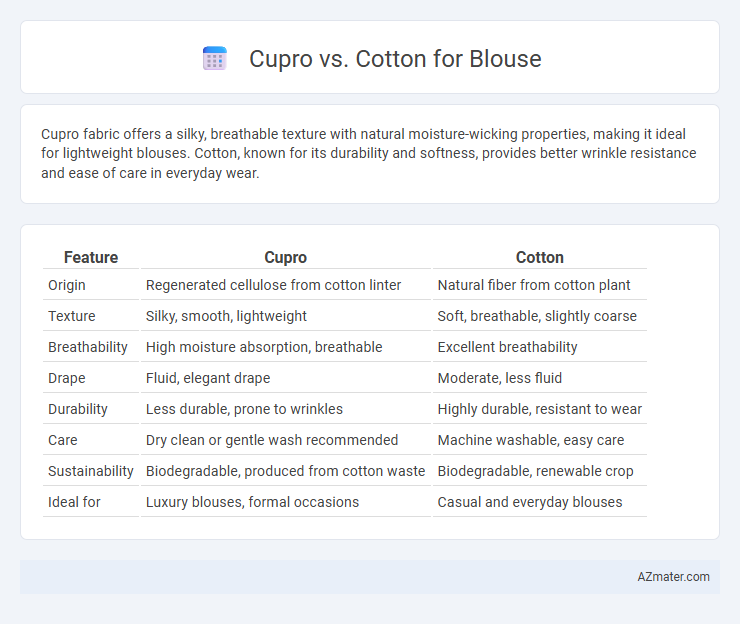Cupro fabric offers a silky, breathable texture with natural moisture-wicking properties, making it ideal for lightweight blouses. Cotton, known for its durability and softness, provides better wrinkle resistance and ease of care in everyday wear.
Table of Comparison
| Feature | Cupro | Cotton |
|---|---|---|
| Origin | Regenerated cellulose from cotton linter | Natural fiber from cotton plant |
| Texture | Silky, smooth, lightweight | Soft, breathable, slightly coarse |
| Breathability | High moisture absorption, breathable | Excellent breathability |
| Drape | Fluid, elegant drape | Moderate, less fluid |
| Durability | Less durable, prone to wrinkles | Highly durable, resistant to wear |
| Care | Dry clean or gentle wash recommended | Machine washable, easy care |
| Sustainability | Biodegradable, produced from cotton waste | Biodegradable, renewable crop |
| Ideal for | Luxury blouses, formal occasions | Casual and everyday blouses |
Introduction: Cupro vs Cotton for Blouses
Cupro and cotton are popular fabrics for blouses, each offering distinct qualities that impact comfort and style. Cupro, a regenerated cellulose fiber derived from cotton linter, provides a silky texture with excellent breathability and moisture-wicking properties. Cotton, a natural fiber, is known for its softness, durability, and ease of care, making it a versatile choice for everyday wear.
What Is Cupro? Key Features Explained
Cupro is a regenerated cellulose fiber derived from cotton linter, offering a silky, breathable, and smooth texture ideal for blouses. Key features of cupro include its eco-friendly production process, excellent moisture absorption, and natural drape that enhances comfort and elegance. Compared to cotton, cupro provides a more luxurious feel with less tendency to wrinkle and improved durability, making it a popular choice for high-quality, breathable blouses.
Cotton Fabric Overview for Blouses
Cotton fabric, made from natural cellulose fibers, is highly breathable and moisture-absorbent, making it ideal for blouses worn in warm climates or during active wear. Its soft texture and durability ensure comfort and longevity, while its ability to retain dye provides vibrant, long-lasting colors for various blouse designs. Compared to Cupro, cotton is more hypoallergenic and easier to care for, requiring basic washing and ironing without special treatments.
Sustainability and Eco-Friendliness Comparison
Cupro, a biodegradable fabric made from regenerated cellulose fibers derived from cotton linter waste, offers a sustainable alternative by utilizing by-products of cotton production that would otherwise be discarded. Cotton, while natural and biodegradable, demands significant water and pesticide use, contributing to environmental strain and limiting its eco-friendliness in conventional farming practices. Choosing cupro for blouses reduces waste and chemical dependency, supporting circular fashion, whereas organic cotton provides an improved but still resource-intensive option in sustainable textile choices.
Comfort and Softness: Cupro vs Cotton
Cupro fabric offers a silky smooth texture that feels luxuriously soft against the skin, making it highly breathable and moisture-wicking, which enhances comfort in blouses. Cotton, known for its natural softness and excellent breathability, provides a lightweight and gentle touch that keeps wearers comfortable throughout the day. While cupro excels in a luxurious drape and smoothness, cotton remains a classic choice favored for its natural comfort and durability in blouse fabrics.
Breathability and Moisture-Wicking Properties
Cupro fabric offers superior breathability and moisture-wicking properties compared to cotton, making it ideal for blouses in warm climates. The cellulose fibers in cupro allow excellent air circulation and quickly absorb and release moisture, reducing discomfort from sweat. Cotton, while breathable and soft, tends to retain moisture longer, which can lead to a damp feeling in high humidity or active conditions.
Durability and Longevity in Everyday Wear
Cupro fabric exhibits superior durability compared to cotton, maintaining its shape and color integrity even after multiple washes and daily use. Cotton, while breathable and comfortable, tends to wear out faster, showing signs of pilling and fading over time with regular abrasion. For everyday blouses, Cupro offers enhanced longevity due to its resilient fiber structure and resistance to shrinkage, making it a practical choice for long-lasting wear.
Care and Maintenance: Cupro vs Cotton
Cupro fabric requires gentle hand washing or dry cleaning to maintain its smooth texture and prevent shrinking, while cotton is more durable and can withstand regular machine washing and higher temperatures. Cupro's delicate fibers are prone to damage from harsh detergents, so using mild soaps and air drying is essential, whereas cotton is more resilient and easier to care for with minimal special treatment. Proper maintenance of cupro ensures a silky finish and breathability, while cotton's natural fiber structure offers robust longevity with low maintenance.
Style and Appearance Differences
Cupro fabric offers a silky, lustrous finish that enhances the elegance of blouses with its smooth drape and subtle sheen, creating a more polished and sophisticated style. Cotton blouses provide a matte, natural texture with greater breathability, resulting in a casual, relaxed appearance ideal for everyday wear. The difference in finish and feel makes cupro suitable for formal, chic looks, while cotton maintains timeless simplicity and comfort.
Which Is Better for Blouses: Cupro or Cotton?
Cupro offers a luxurious feel with its smooth, silk-like texture and excellent breathability, making it ideal for lightweight, elegant blouses that drape beautifully. Cotton provides superior durability, moisture absorption, and ease of care, making it a practical choice for everyday blouses that require frequent washing and long-lasting wear. Choosing between cupro and cotton depends on whether you prioritize softness and a sophisticated look or robustness and maintenance simplicity in your blouse fabric.

Infographic: Cupro vs Cotton for Blouse
 azmater.com
azmater.com